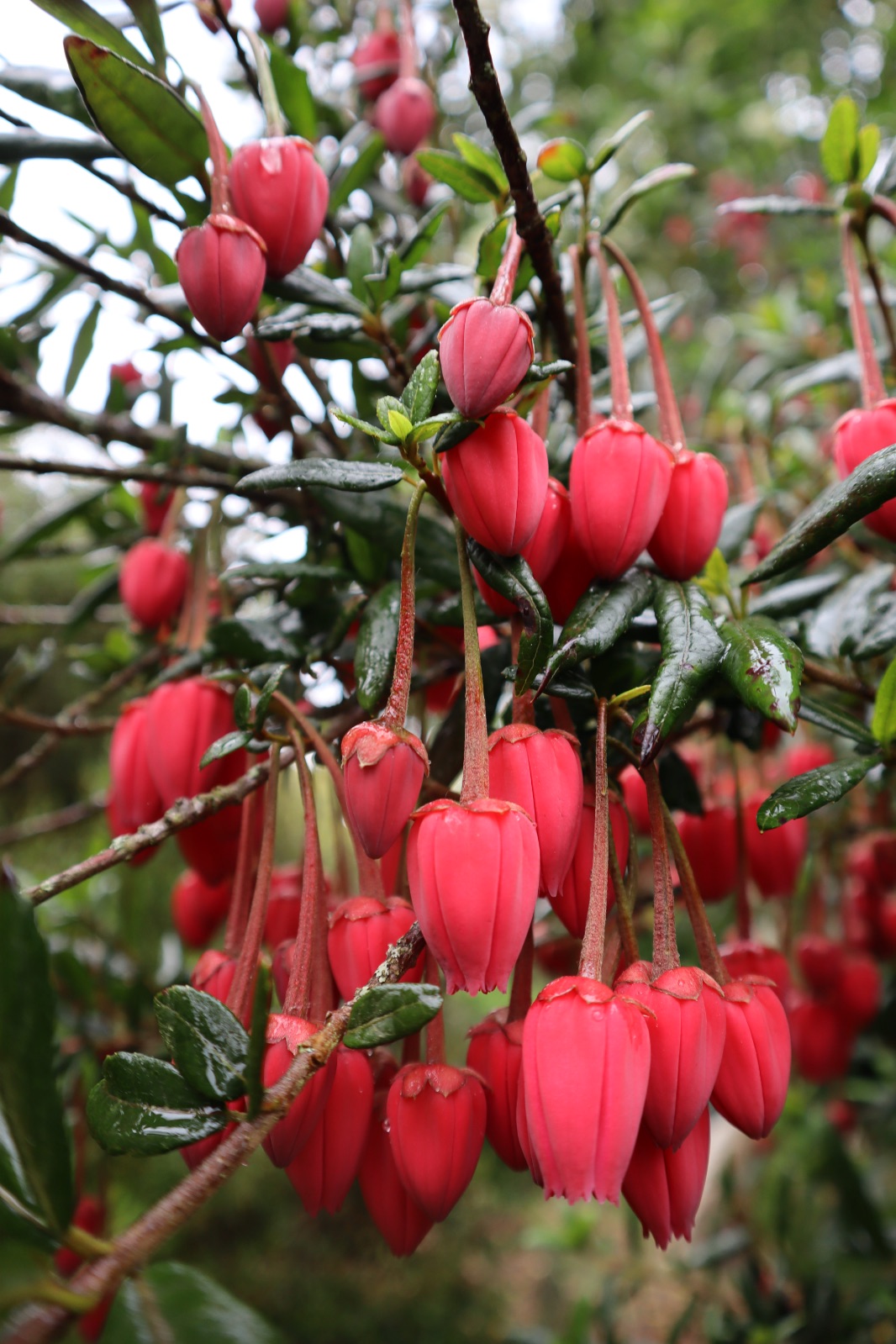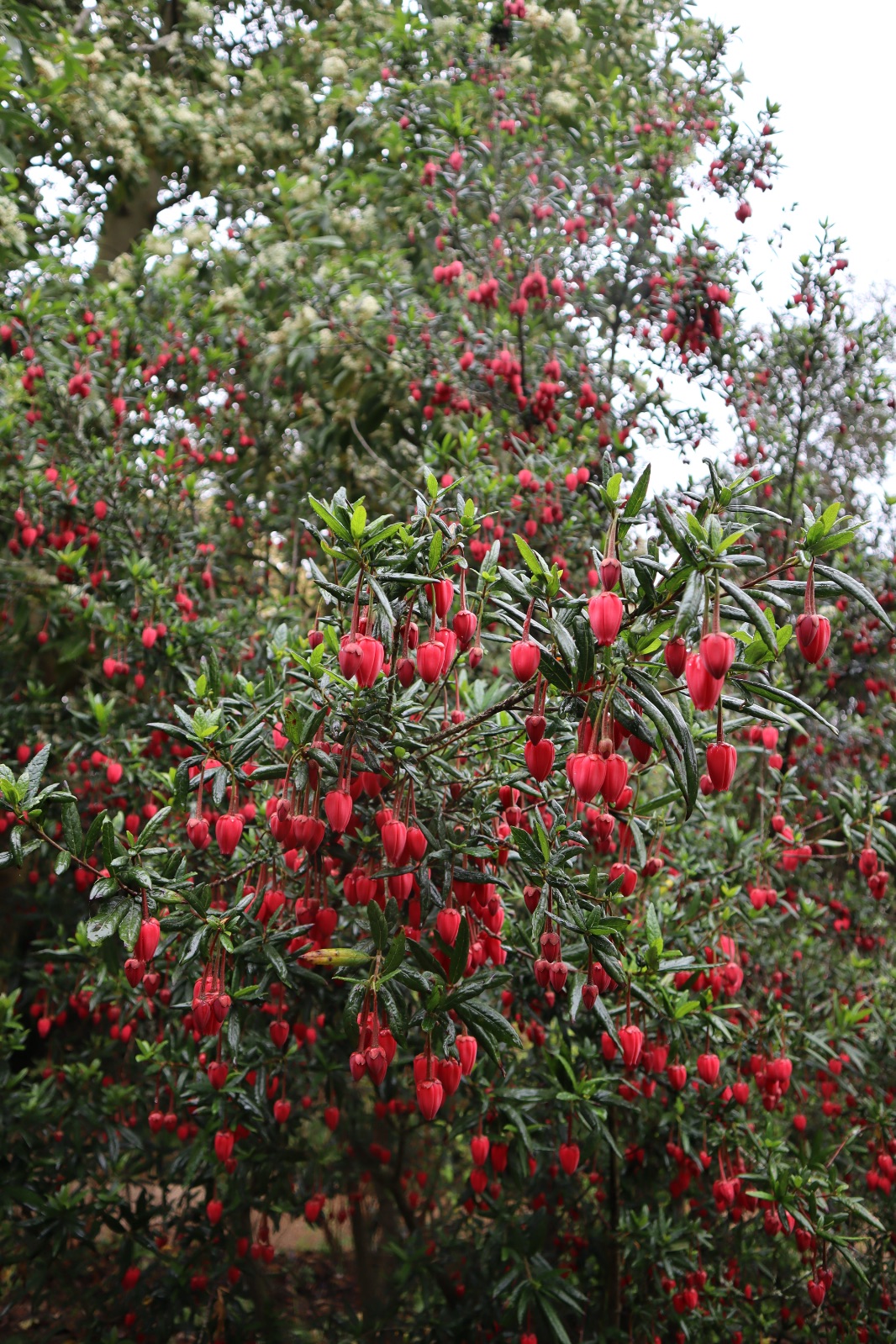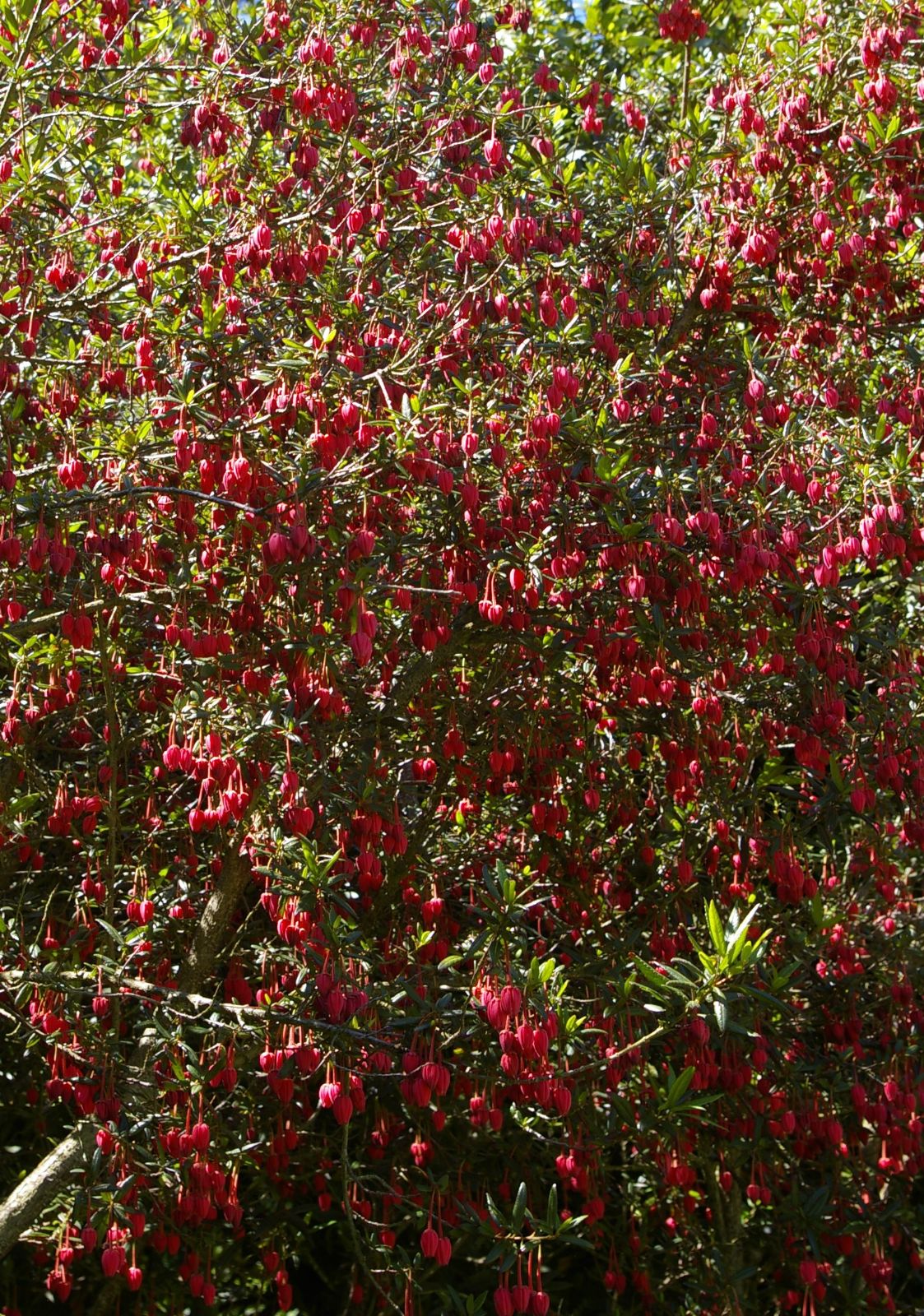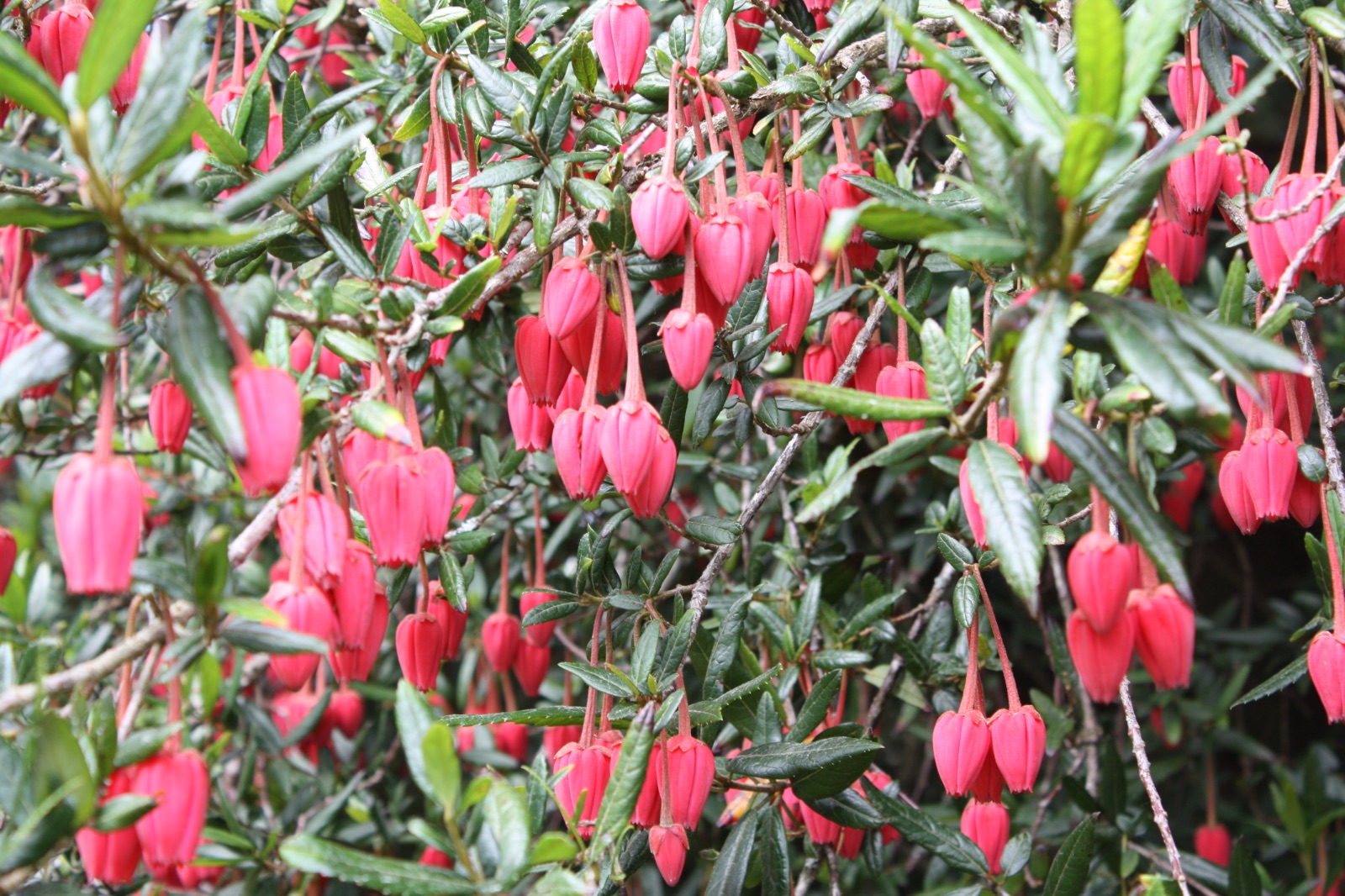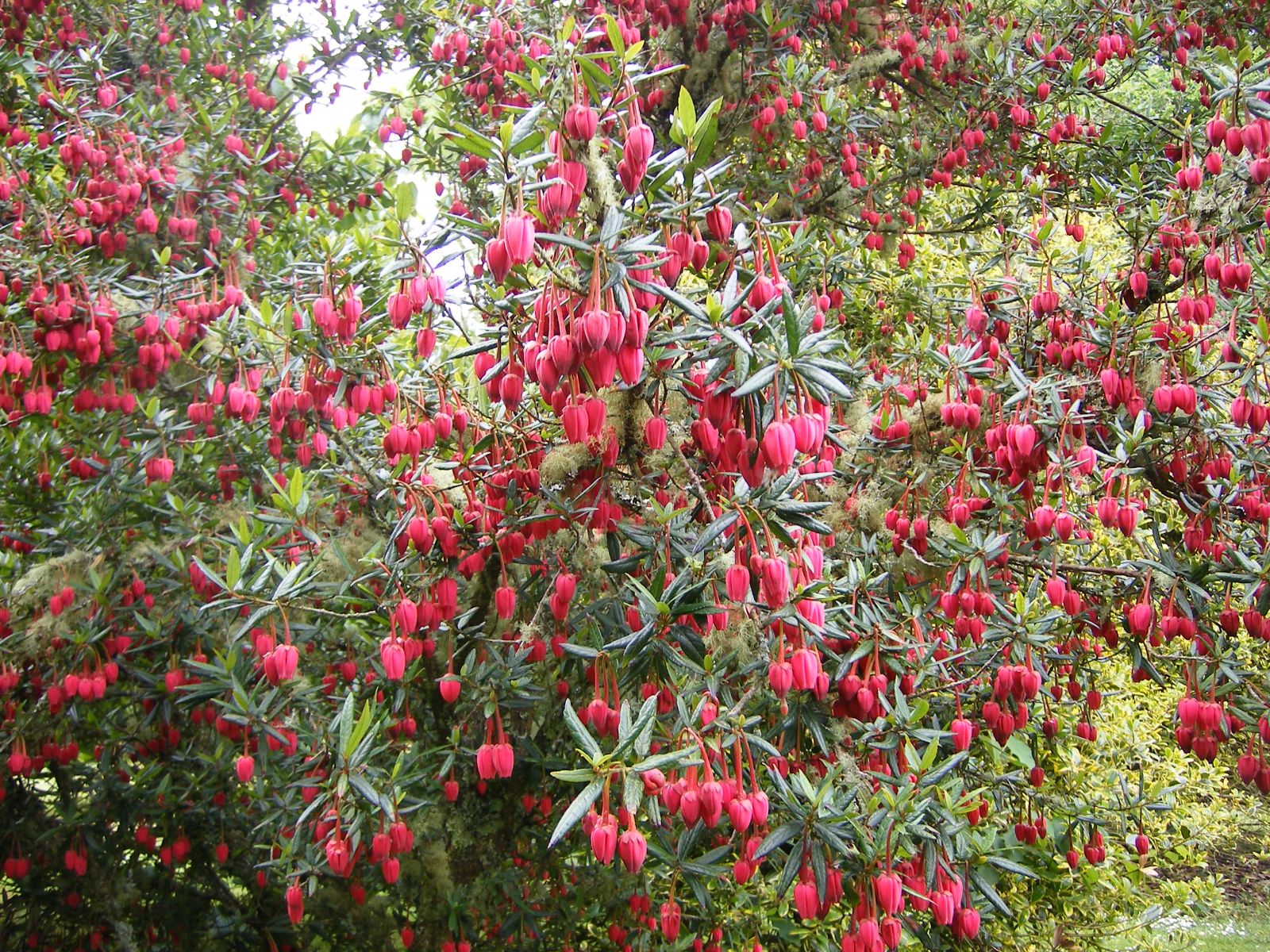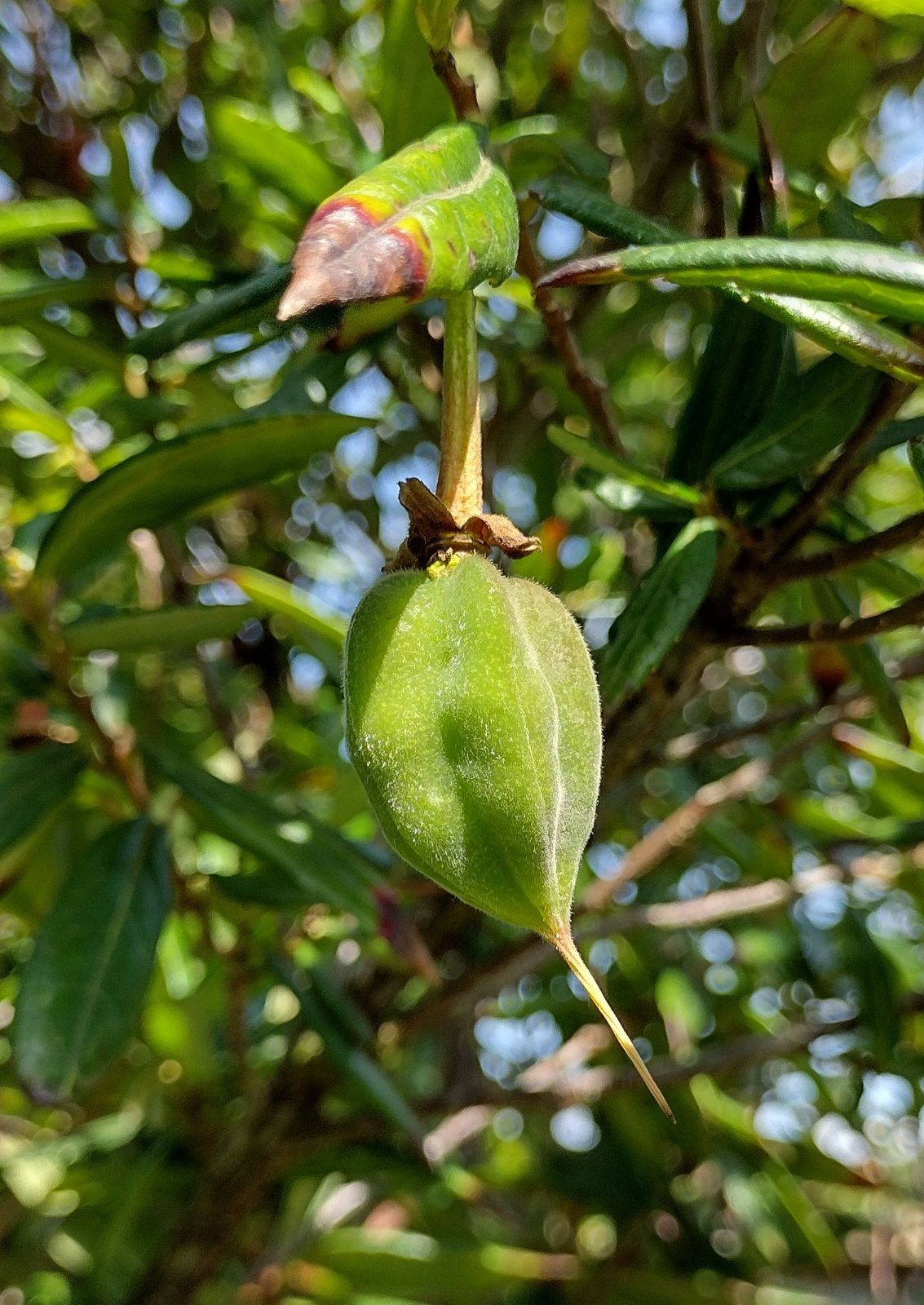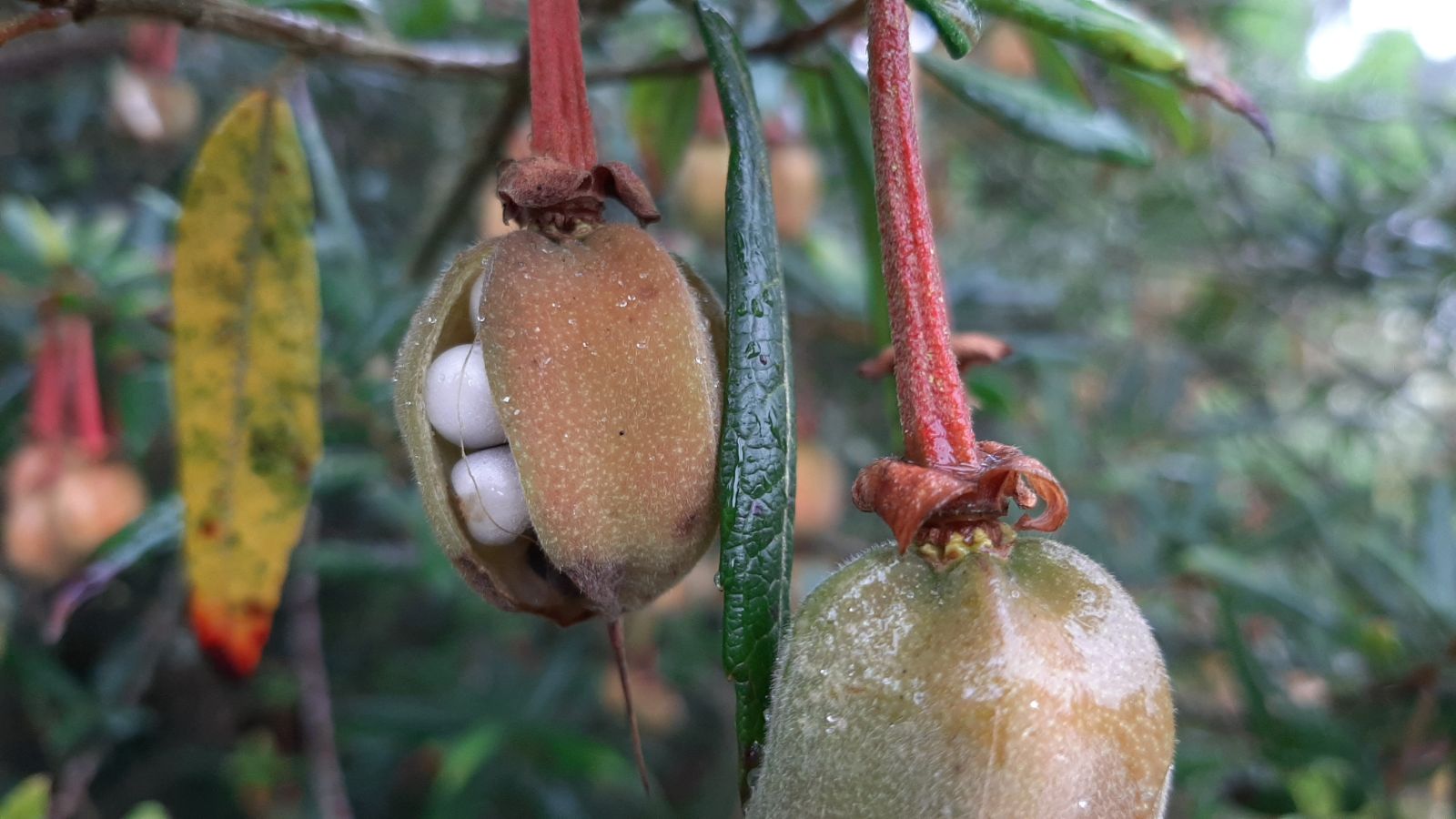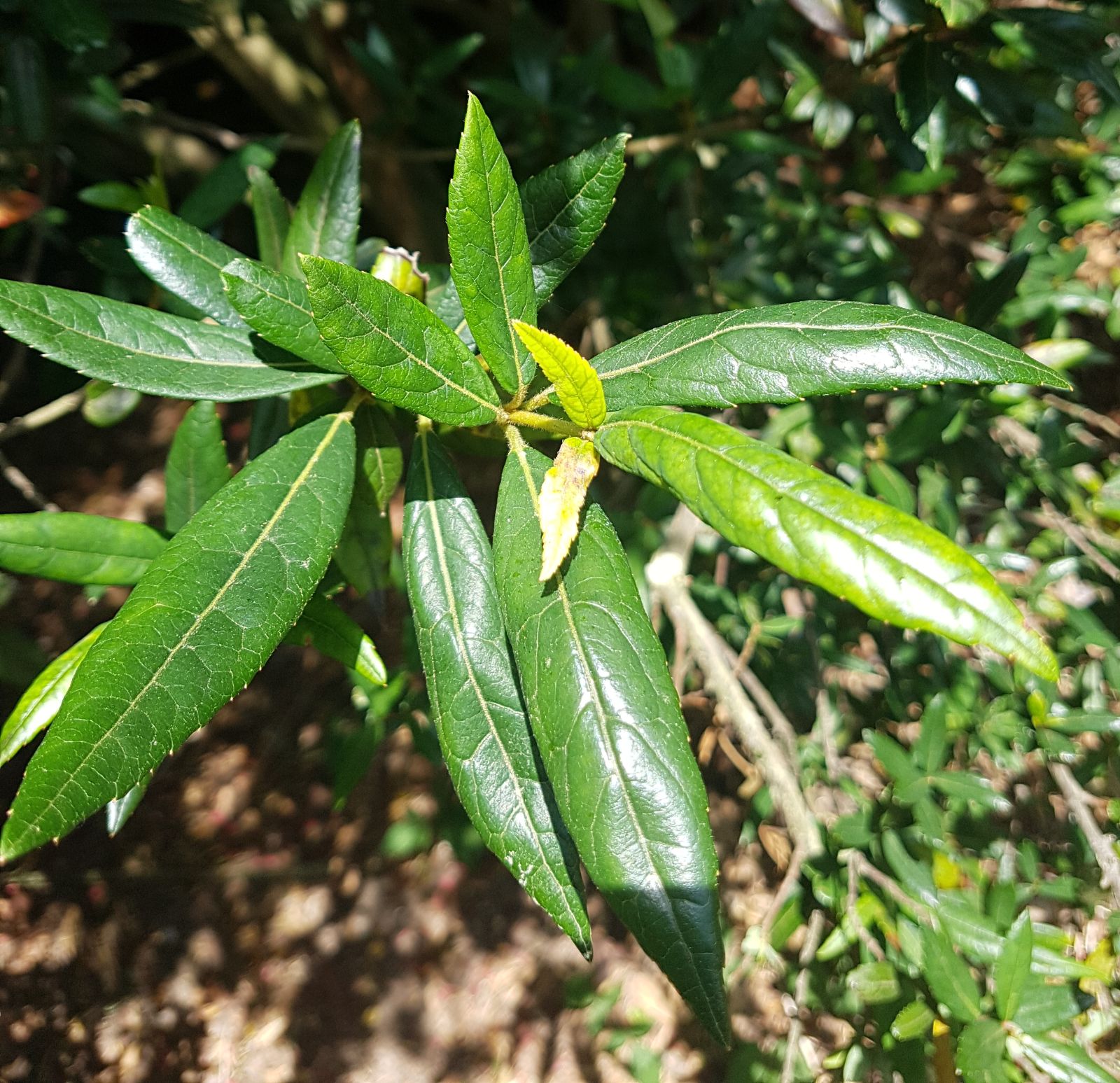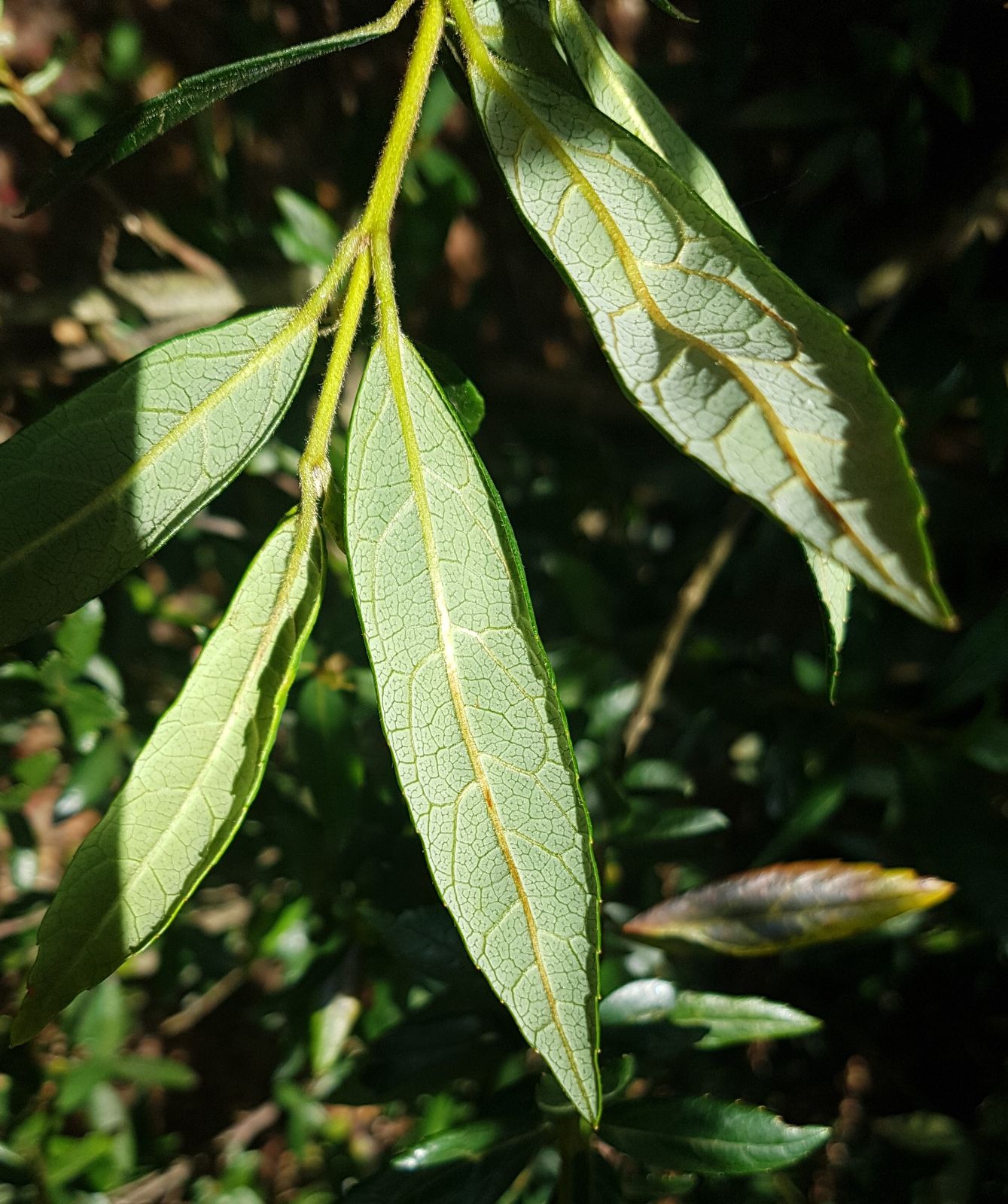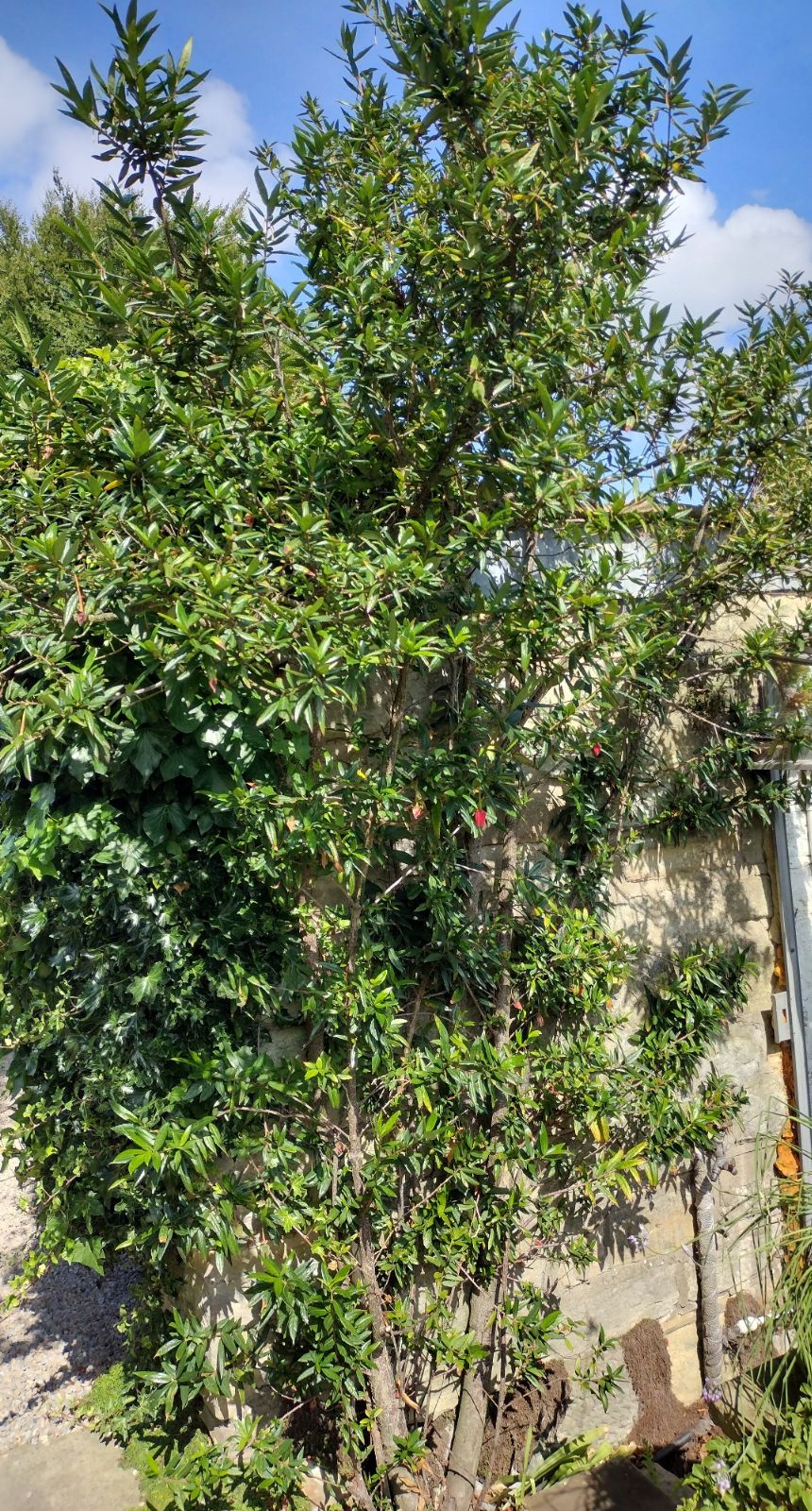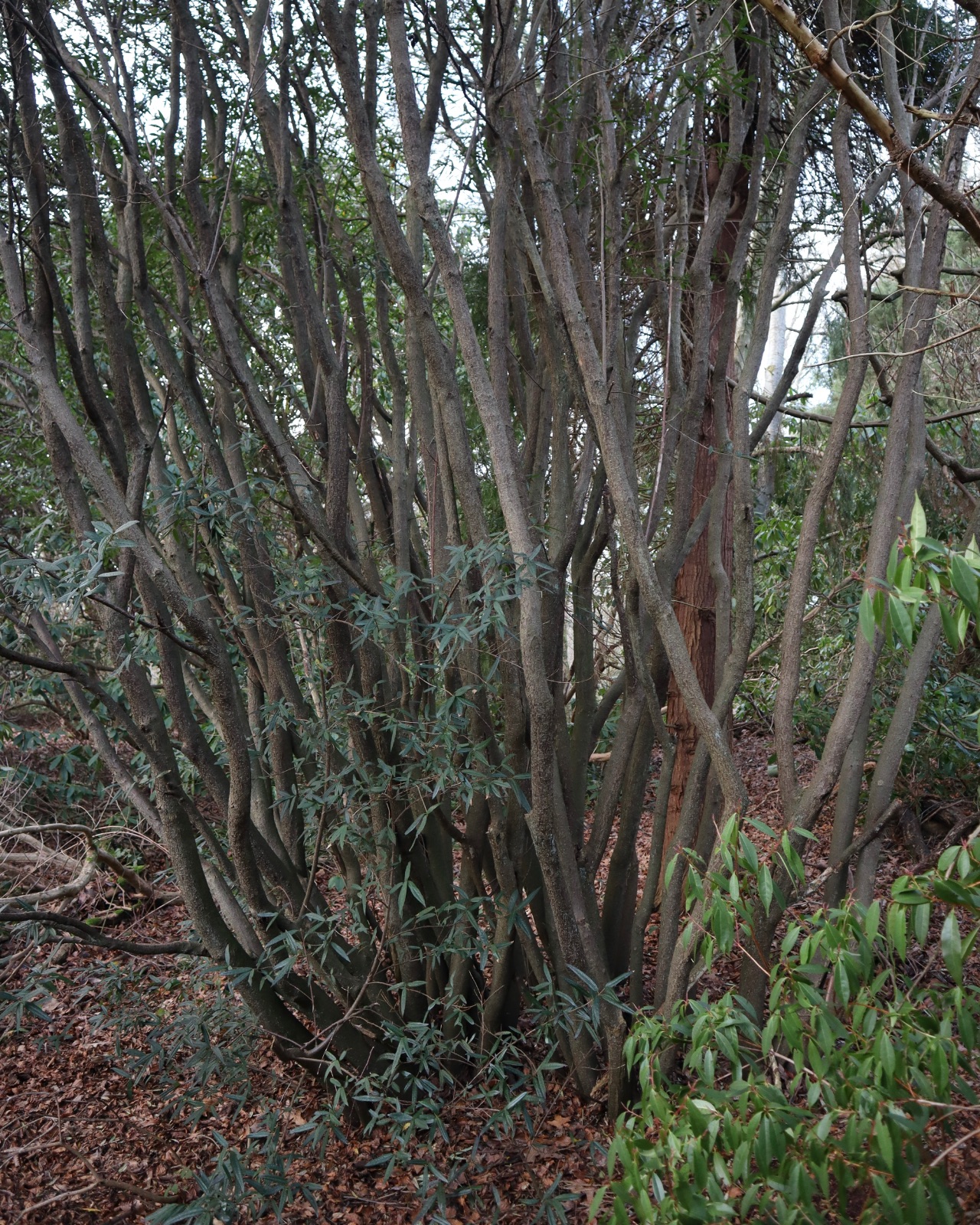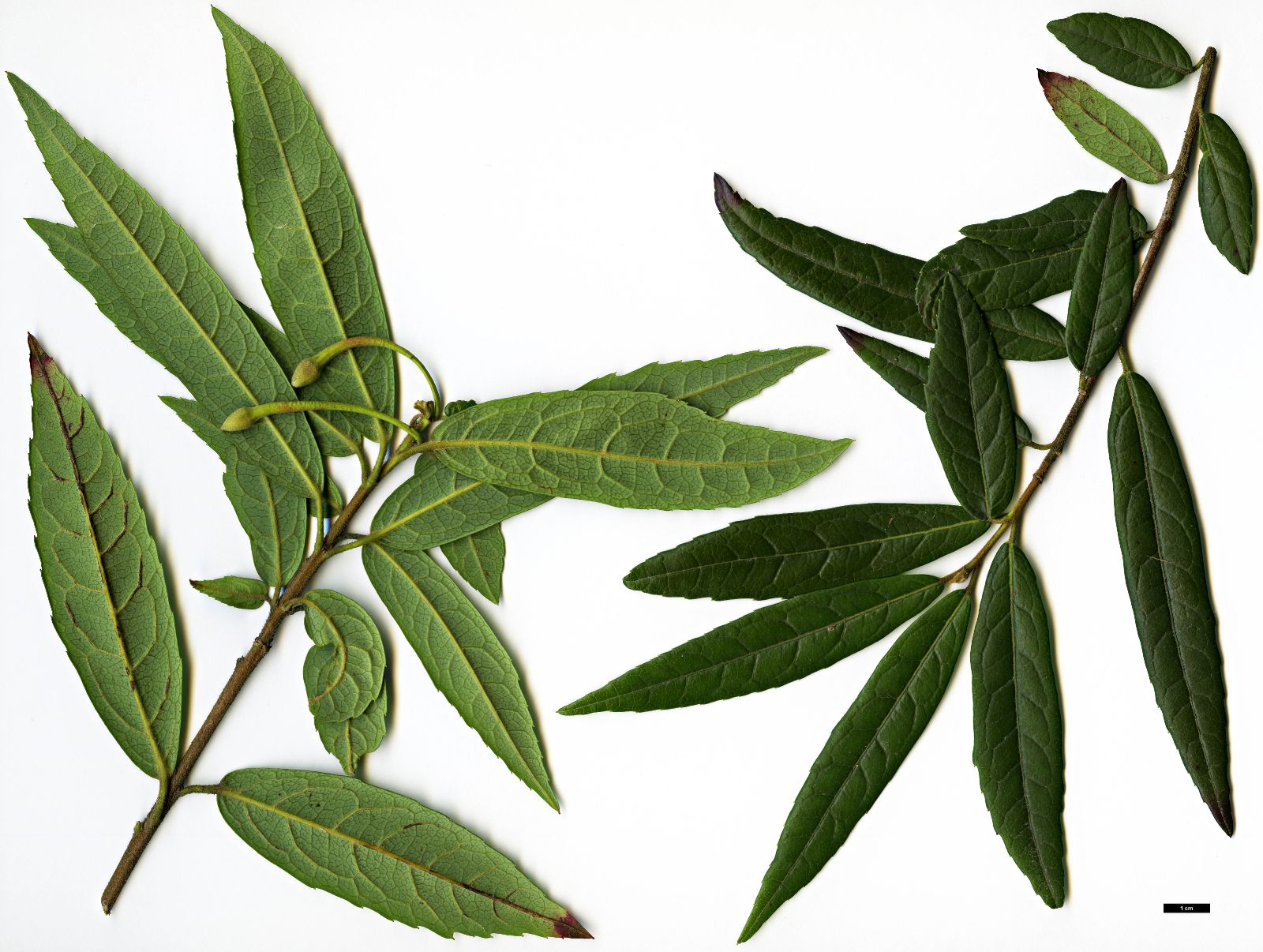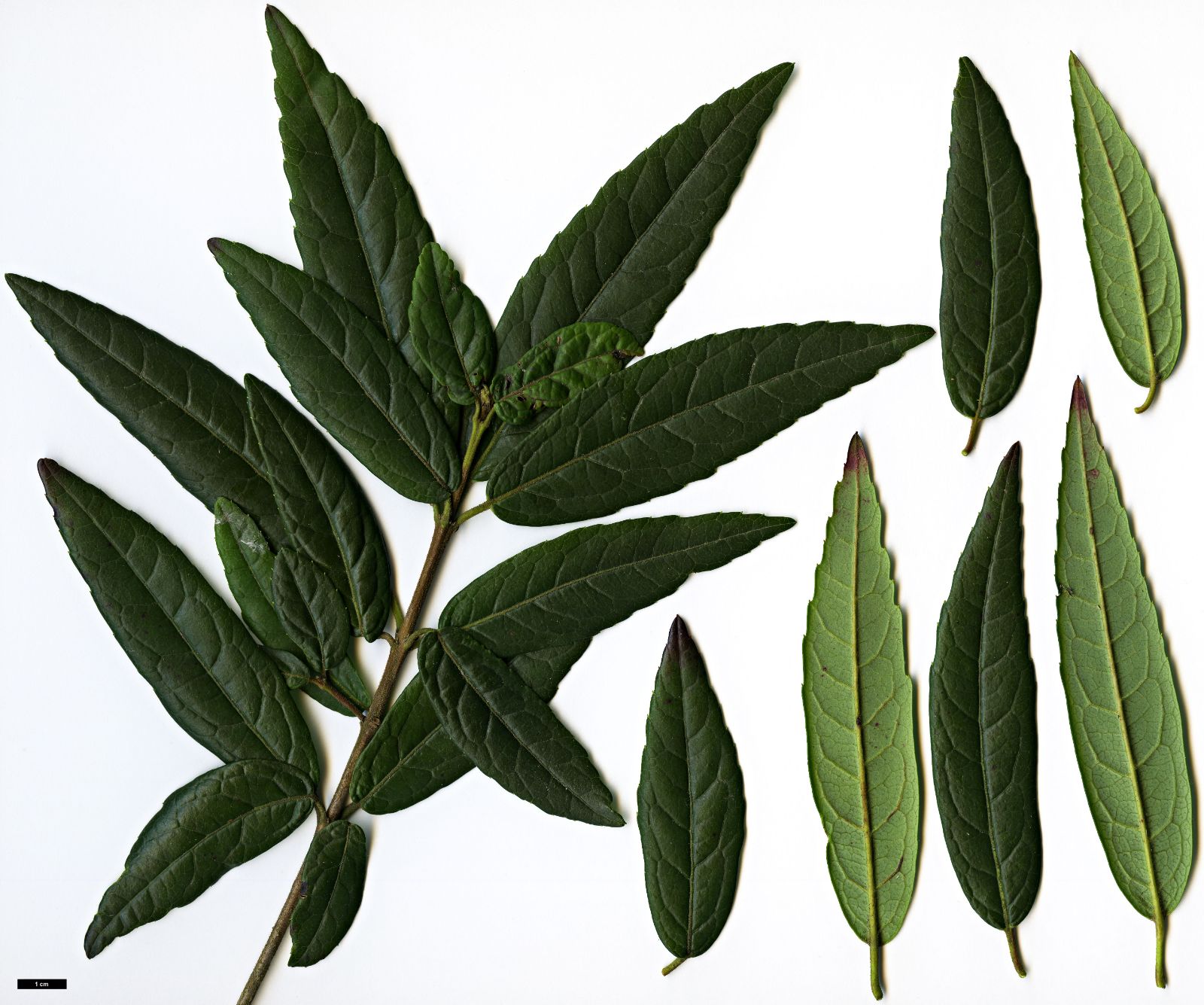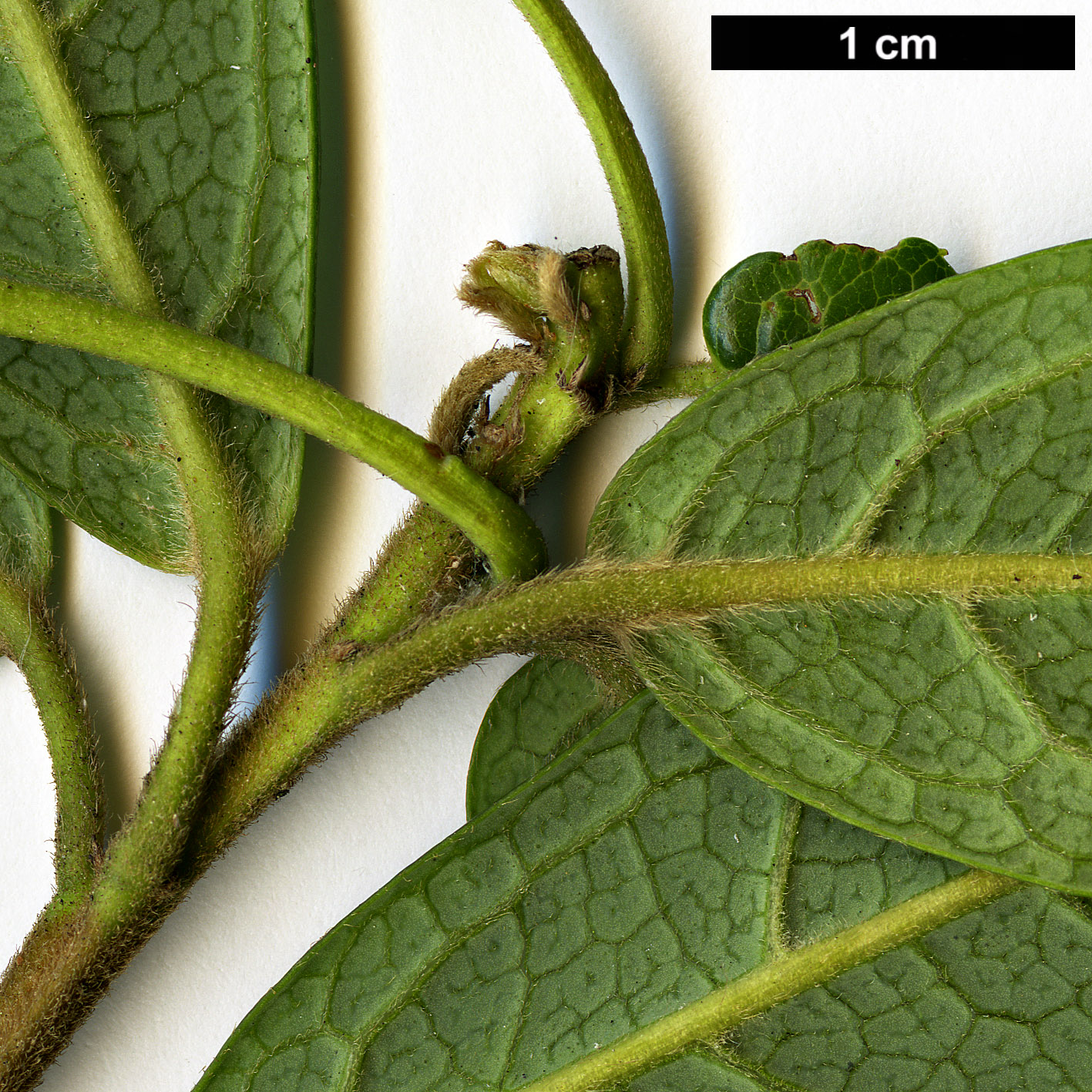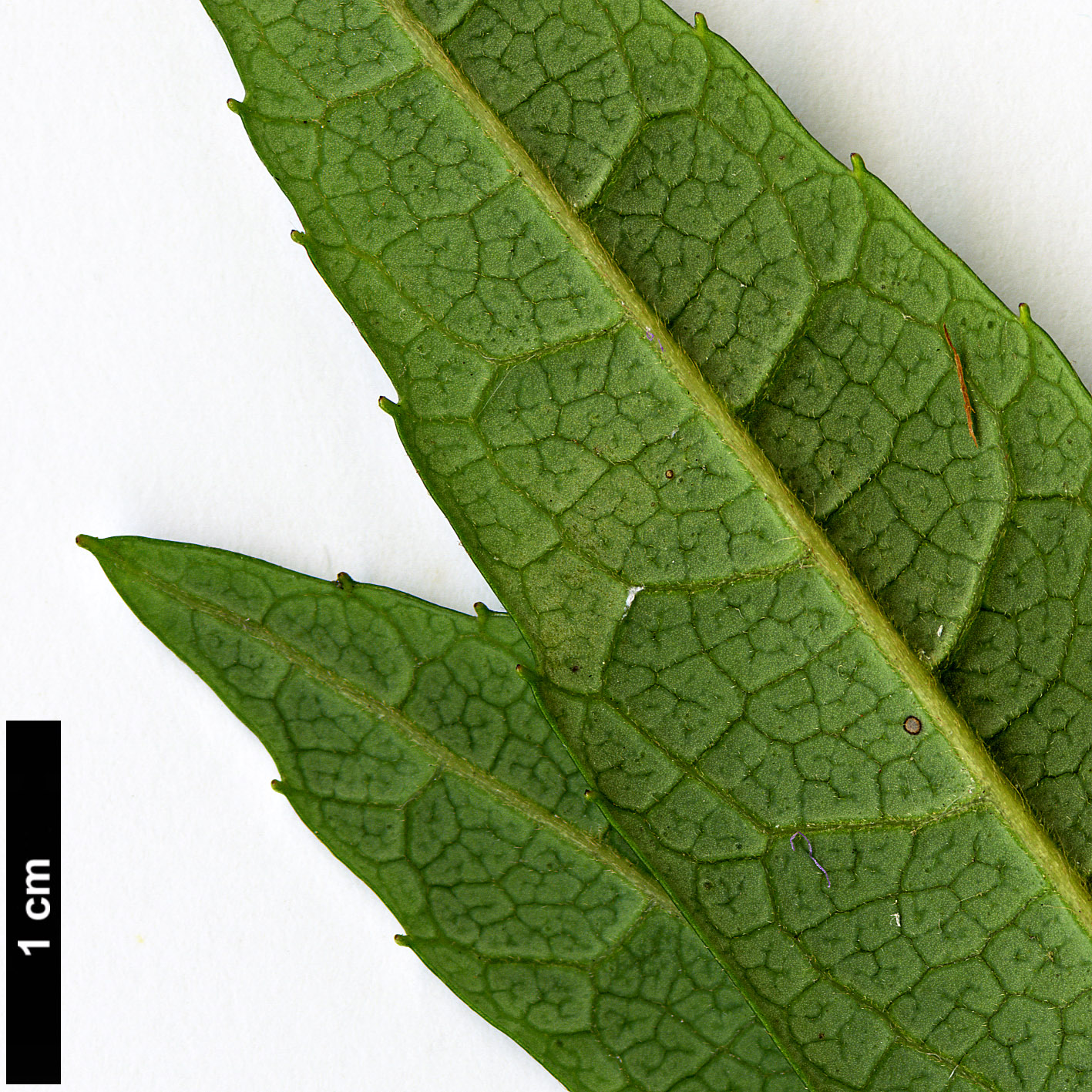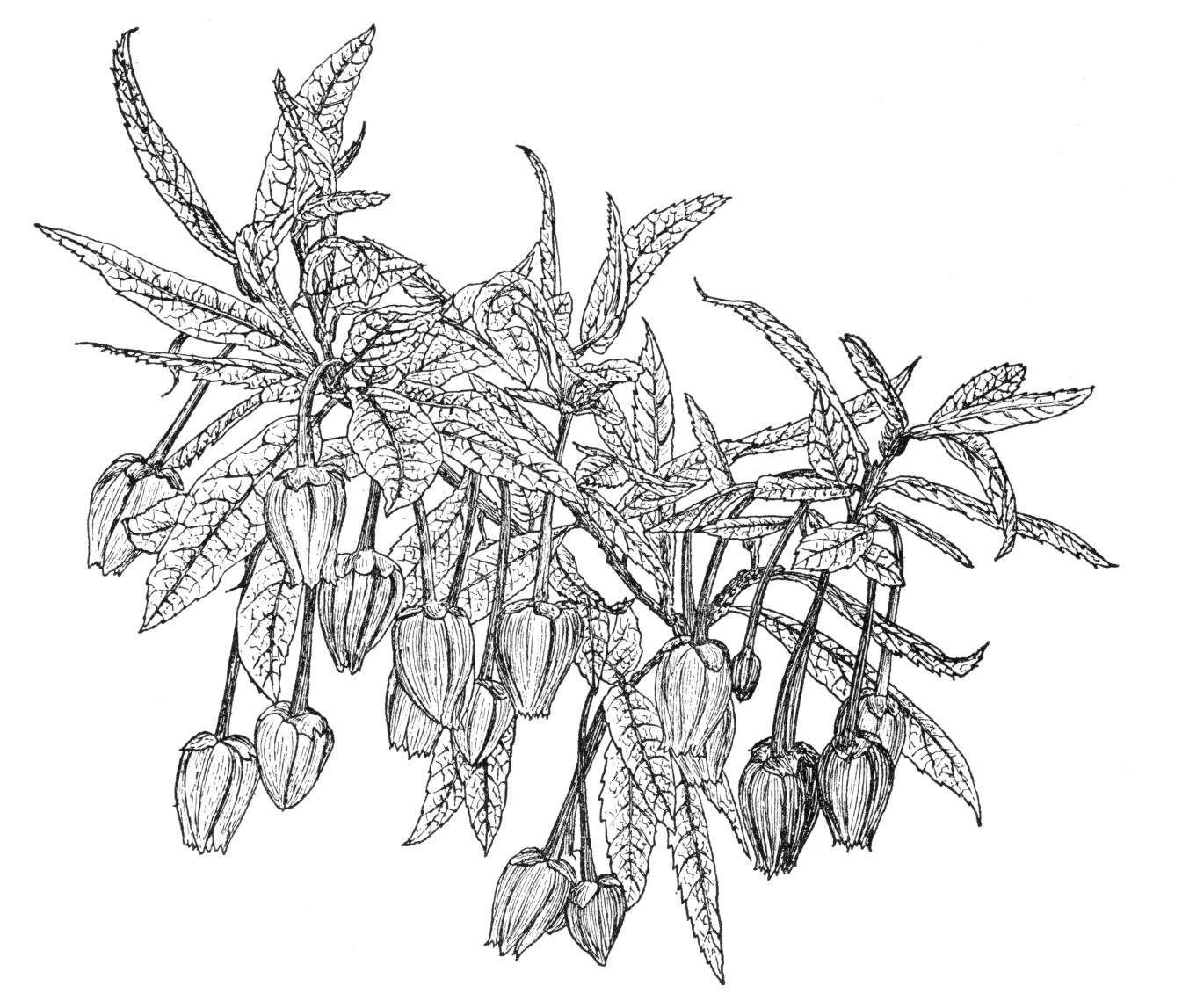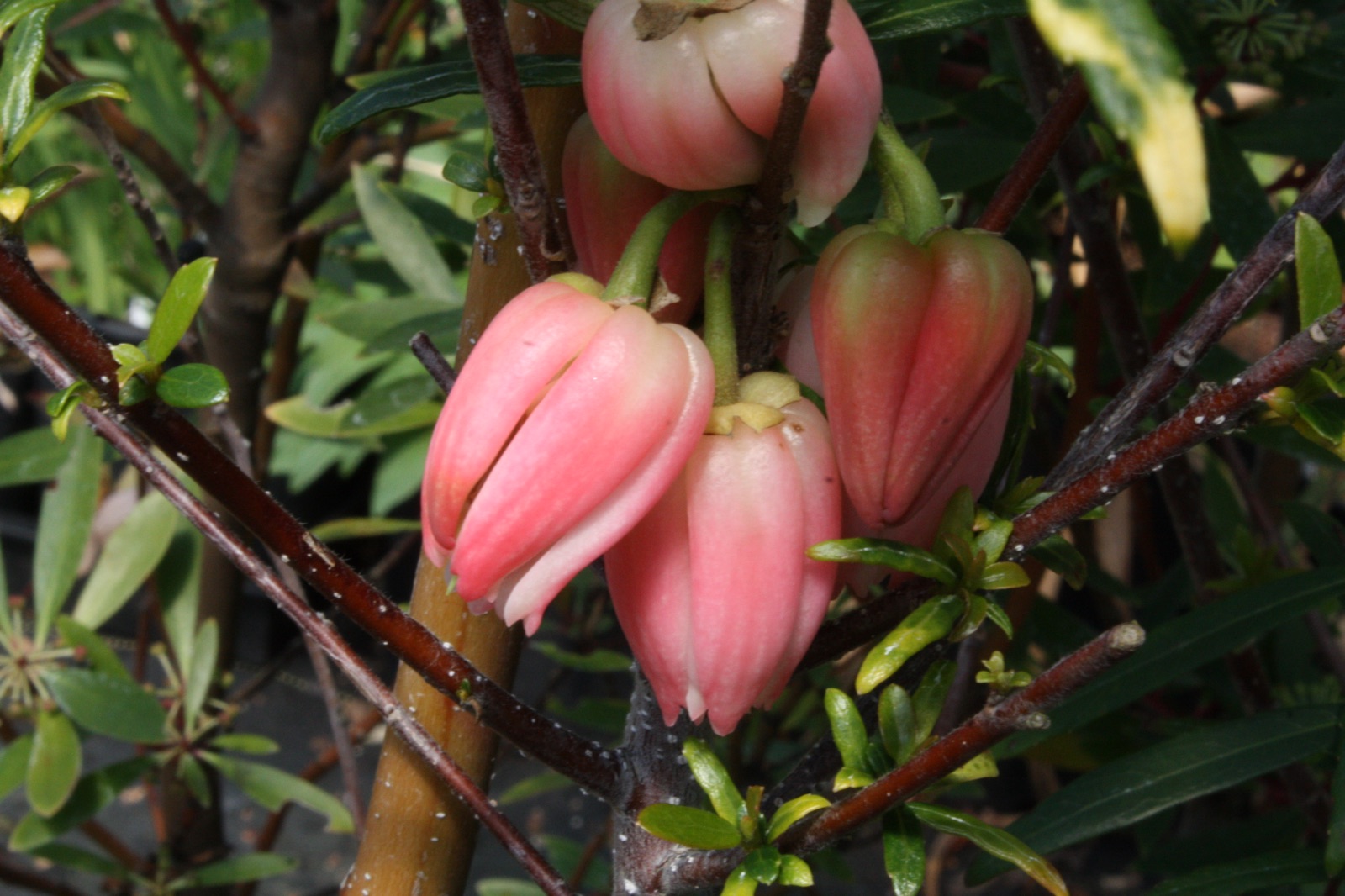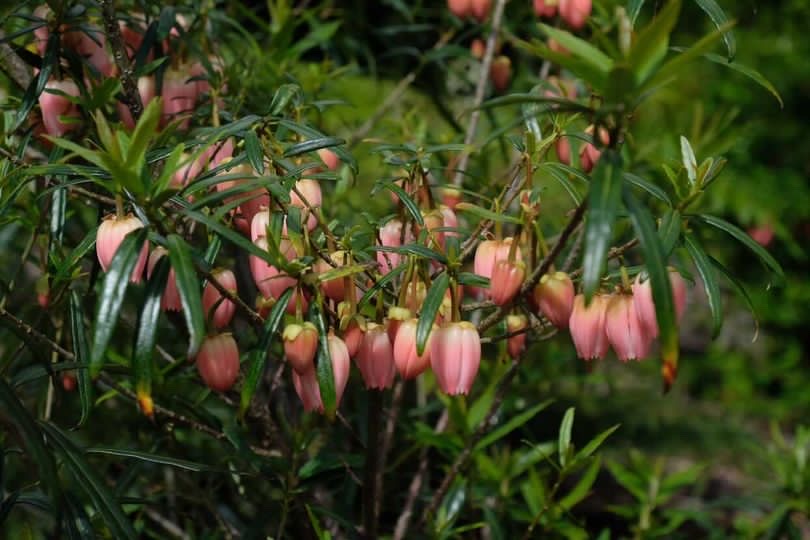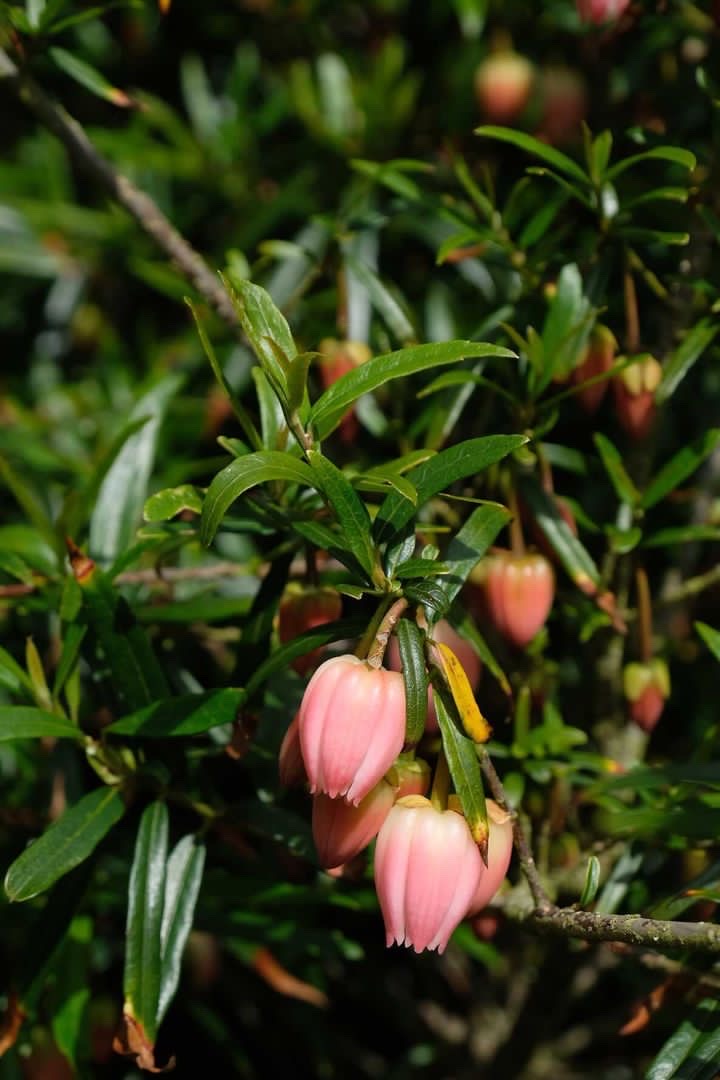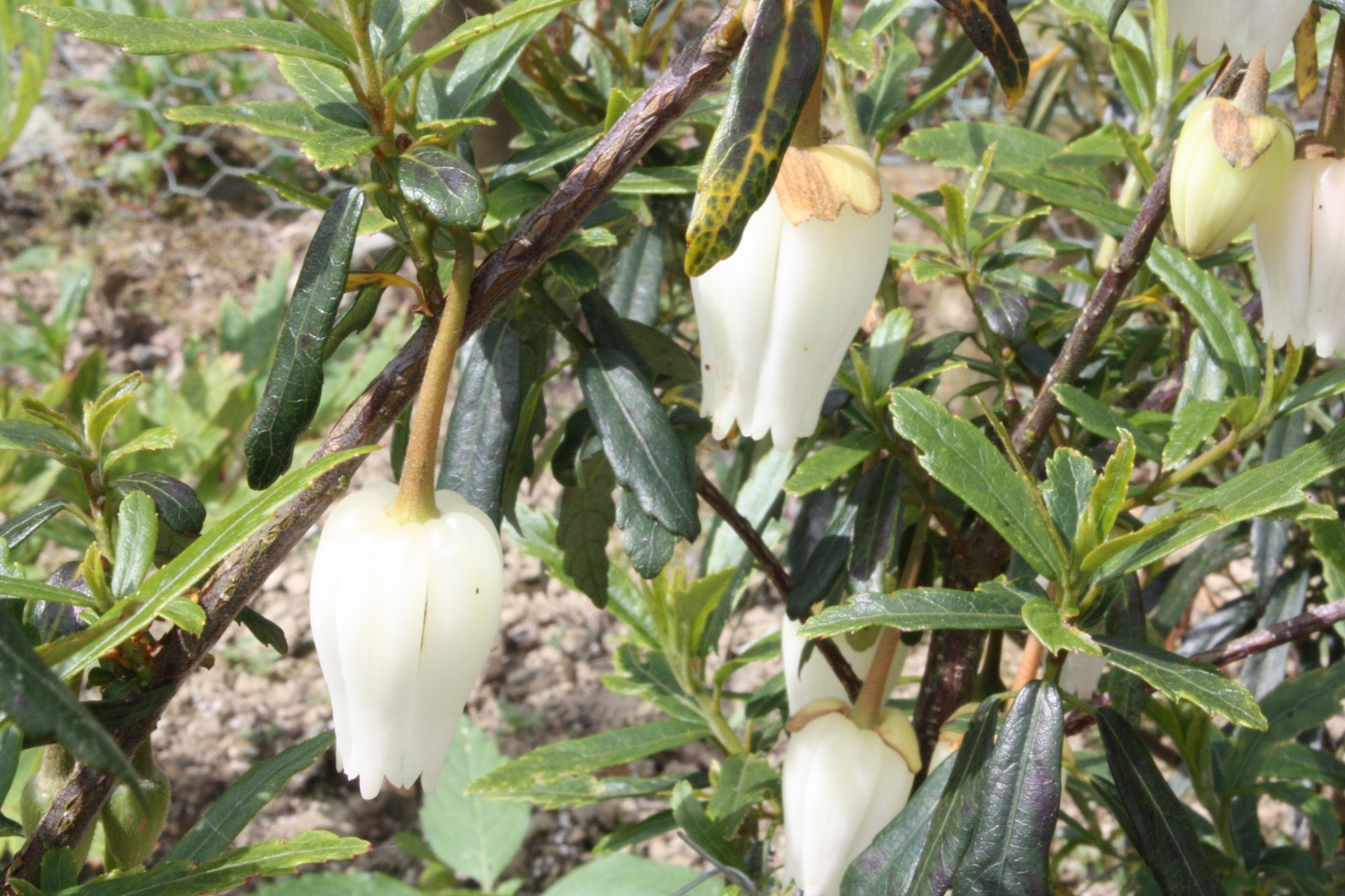Crinodendron hookerianum
Sponsor
Kindly sponsored by
a member of the International Dendrology Society
Credits
Jack Aldridge (2022)
Recommended citation
Aldridge, J. (2022), 'Crinodendron hookerianum' from the website Trees and Shrubs Online (treesandshrubsonline.
Genus
Common Names
- Chilean Lantern-tree
- polizon
- chaquihue
Synonyms
- Tricuspidaria lanceolata Miq.
- Tricuspidaria dependens Hort., not Ruiz & Pavon
- Crinodendron eriocladum Gand.
Large shrub or small tree, 3–8 m tall. Twigs pubescent, becoming glabrescent, grey, turning amber with age. Leaves opposite, occasionally alternate, or whorled, oblong-lanceolate, 1.5–8 × 0.7–2.1 cm, dark green above, paler beneath. Margins serrate or occasionally entire. Petioles 1.5–9 mm long. Flowers urn-shaped, produced singly from terminal leaf-axils on stalks 2–5 cm long. Petals 5–6, fleshy, 14–24 × 3–8 mm, apex shallowly toothed, not overlapping, pubescent on outer surface, colour scarlet to carmine. Capsule subglobose, 1.5–4.5 × 1–2 cm, pubescent. Seeds spherical, covered in a whitish bloom. (Bean 1981; Bricker 1991; Gardner 2011).
Distribution Chile Valdivia south to Chiloe and Chaitén.
Habitat An understorey component of Valdivian temperate rainforests dominated by evergreen Nothofagus spp., often near watercourses.
USDA Hardiness Zone 9a
RHS Hardiness Rating H4
Awards RHS Award of Garden Merit
Conservation status Not evaluated (NE)
Among the many exciting plants introduced to gardens from Chile one of the most spectacular has to be the Chilean Lantern-tree, Crinodendron hookerianum. Bean (1976) regards it as ‘one of the most attractive of all shrubs’ where it succeeds; an established specimen in full flower is an enchanting sight.
Native to southern Chile, where it is known as chaquihue, it has a limited distribution from Valdivia south to Chiloé Island (Bricker 1991). It is mostly found growing in temperate Valdivian rainforest along watercourses where, along with the likes of Amomyrtus luma, Myrceugenia parvifolia and Tepualia stipularis, it forms an understorey in forests of evergreen Nothofagus (Gardner, Hechenleitner & Hepp 2015; Bricker 1991). It was first introduced to the UK by William Lobb in 1848, collecting for James Veitch & Sons, and subsequently by Richard Pearce ten years later in the same capacity (Noble 2009). Although introduced as Tricuspidaria lanceolata, as which it was known as for some time, the currently accepted name honours W.J. Hooker, Director of the Royal Botanic Gardens, Kew at the time of Lobb’s and Pearce’s introductions (Veitch 1906).
The English common name “Chilean Lantern-tree” is particularly appropriate; the pendulous flowers look just like rich crimson lanterns, hanging in profusion from the branchlets on long pedicels. The overall effect in flower is quite spectacular, looking rather like a well-decorated Christmas tree hung with baubles. In Chile it is also known as polizon, the Spanish word for a stiffened petticoat known as a crinoline, which the flowers resemble (Gardner, Hechenleitner & Hepp 2015). Flowers typically emerge in late spring or early summer from buds that curiously form during the previous autumn (Bean 1981). Occasionally new growth borne in spring will bear some flower too, providing something of a second display later in summer, albeit less spectacularly (Hogan 2008). In habitat, they are pollinated by hummingbirds, with typical floral features of such species (Gardner, Hechenleitner & Hepp 2015).
Wild populations show little variability with flower colour, typically shades of crimson. The same could be said for those in cultivation in our area, with no named selections until more recently, although a handful of colour variants are cultivated in Chile and are available in the nursery trade, including pale pink and white-flowered forms (Gardner, Hechenleitner & Hepp 2015; Clayton 2020). Roy Lancaster (pers. comm. 2022) recalls buying a supposedly white-flowered plant from a nursery in Frutillar, although disappointingly this flowered red. A pale-pink flowered seedling originally found in the wild is known as ‘Ada Hoffmann’; its introduction seems to be shrouded in mystery, but this clone has played a key role in bringing different colour forms into wider cultivation (see below).
Growing in deep shade in habitat, Crinodendron hookerianum is usually seen as a scrawny, laxly branched shrub, although in gardens and in ideal spots in the wild it has the potential to make a very handsome, upright small tree to 8 m or more. Like many other Chilean forest species grown in northern gardens it prefers a shaded position and demands a humus-rich, moisture retentive soil with a low pH. With regards to siting, William Arnold Forster (1948) recommended a west-facing position, where the evening light is able to illuminate its flowers, ‘brightening its rose to scarlet’. Failing such romantic ideals, a sheltered site out of cold, drying winds will reduce the leaf scorch and defoliation often seen on specimens in more exposed locations (pers. obs.). An RHS H4 hardiness rating indicates some tolerance of periods to –10°C without damage (Royal Horticultural Society 2022), however some dieback is inevitable during periods of –5°C or lower, but this is sometimes repaid by vigorous regrowth the following spring. Sean Hogan (2008) recounts how specimens subjected to periods of –18°C in Portland, Oregon resprouted from ground level, reaching flowering size again within just two years; Tom Christian recounts a similar experience at Cluny House Gardens (Perthshire, UK) where an established plant was also cut back to ground level by –18°C in the winter of 2010–11, but while this plant has grown back vigorously it took over ten years to flower again (T. Christian pers. comm. 2022). To guarantee regular flowering and to ensure a fuller furnishing of foliage in colder, more exposed locations, a position with shelter from neighbouring evergreens is advisable.
With a preference for cool summers, mild winters and reliable moisture, it is not suprising that the best examples in our area are found in regions with a pronounced maritime climate. In particular, in parts of Ireland and the west coast of Scotland Crinodendron hookerianum can be seen to reach incredible proportions, with large multi-stemmed shrubs 10–14 m tall not uncommon (Tree Register 2022). One notable Irish example grows at Kilmacurragh, Wicklow, that is thought to be from William Lobb’s original introduction, 13 m tall with a 148 cm girth on multiple stems when last measured in 2014 (S. O’Brien pers. comm. 2022).
'Ada Hoffmann'
An attractive pale-pink flowered clone with an uncertain background, thought to have been found in the wild in southern Chile (Edwards & Marshall 2019). It was first listed in RHS Plant Finder in 2002, although how and when it arrived in cultivation remains unknown. The cultivar name honours Chilean dendrologist and environmentalist Adriana Hoffmann (1940–2022) (Clayton 2020), but whether she had any involvement in collecting or introducing it is in doubt (M. Gardner pers. comm. 2022). In gardens this cultivar remains relatively rare, both due to lack of availability and its slow-growing nature; it appears to be less tolerant of exposure and low temperatures than the typical species, and is shy to flower as a result (pers. obs.).
Similar pale pink clones have been flowered from wild-collected seed at Logan Botanic Garden in Scotland (J. Nix pers. comm. 2022). Of note is a plant raised from BCCG 1027, a collection made in Los Lagos in 2017 (under accession number 20180839*F) and another from a Paulina Hechenleitner collection in 2004 (under accession number 20040029*I) (Royal Botanic Garden Edinburgh 2022). It is unknown whether other seedlings from these collections growing at other sites have exhibited the same colour variation from the type. Seedlings of ‘Ada Hoffmann’ have given rise to two cultivars selected in Ireland that have become available in recent years – see below (Butler 2020).
'Alf Robbins'
The most exciting variation shown to date; a long-awaited, white-flowered cultivar from Ireland, introduced wholesale to the UK by Jan Ravensberg in 2020. Raised from seed collected from ‘Ada Hoffmann’, seedlings were selected based on their foliage. Thrillingly, one with handsome, dark green, more obviously lobed leaves eventually flowered white! It was named by way of gratitude to the man who initially sent the seed to Ravensberg (Butler 2020; Clayton 2020). At least one other unnamed, white-flowered clone has been reported to be in cultivation prior to this introduction (Edwards & Marshall 2019).
'Ashmount'
Another recent introduction from Jan Ravensberg in Ireland, named for his home Ashmount House in Co Offaly, derived from the same batch of seedlings as ‘Alf Robbins’. Selected for its distinctive, long, slender leaves, its flowers proved to be a deeper rose-pink than its parent (Butler 2020).

